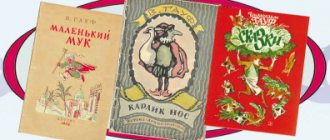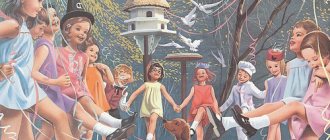Hello, dear friends! Today is the most fabulous day on the Shkolala blog.
Today we will compose mathematical fairy tales.
Below you will find a turnip, Ivan the Fool, numbers, Baba Yaga, geometric figures and mathematical signs. We hope that your trip to the country of Mathematics will be interesting and educational for you and your little schoolchildren, and at the same time will help you create your own unique project for 3rd grade.
We begin.
And first we present to you the fairy tale “Turnip”. Only it’s not just “Turnip”, but a mathematical turnip.
How Ivanushka the Fool went for happiness
In a certain kingdom, in a certain state, there lived Ivanushka the Fool. And he decided to go for happiness.
His path lay through a dark forest. Ivanushka is walking through the forest and sees some kind of cross lying on the path.
“What else is this?” thinks the good fellow. “Let me throw this cross into the swamp.”
He took the cross in his hand and suddenly heard a thin voice: “Don’t throw me into the swamp, Ivanushka! I'm afraid of frogs. And in general I’m not a cross, but a plus. Better take me with you, I’ll still be useful to you.”
Ivanushka the Fool was surprised, but just in case he put the plus in his pocket.
Ivan walks further and suddenly trips over a straight stick.
“Oh, you little stick of wood! - Ivan got angry. - Almost ruined my bast shoes! Now I’ll break you in half!”
Fool Ivanushka took the wand in his hands and suddenly heard a thin voice: “Don’t break me, Ivanushka! It’s your own fault for not looking at your feet! And in general, I’m not just a stick, I’m a minus. Take me with you, maybe I’ll be useful to you.”
Ivan the Fool was surprised, but he put the minus in his pocket and continued on his way.
He walks under the giant fir trees and suddenly there is a SLAM on his forehead.
"Oh! - Ivan the Fool was scared. - What fell on me from the tree? Is it a bump or something?
“You’re a big shot yourself!” said a thin voice from the grass. “I’m not a bump, but a multiplying sign!”
“What were you doing at the Christmas tree?” asked Ivanushka.
"What? What? I multiplied the cones! Instead of asking stupid questions, take me with you, I’ll be useful to you,” said the multiplication sign.
Ivanushka put the multiplication sign in his pocket and walked on.
And by that time it was dark in the forest.
Ivan the Fool walks and sees two small green eyes looking at him from behind a bush.
“Hey, who's there? - Ivanushka shouted. “Come out, monster monster, we’ll fight!”
“Why are you calling me names? - a thin voice squeaked offendedly. “I’m not a monster or a monster, but a sign of division.” Take me with you, I’ll be useful to you.”
Ivanushka the Fool took the division with him and moved on.
Ivanushka walked briefly through the dense forest for a long time, and suddenly he saw grandfather Lesovik sitting on a stump. The good fellow decided to ask him the way to happiness. He approached Lesovik, bowed low and said: “Tell me, grandfather Lesovik, do you know where I can look for happiness?”
“Of course I know,” answered Lesovik, “feed me, I’ll show you the way.”
“What will I feed you? I only have one cabbage pie with me. Do you want me to break off half?” Ivan suggested.
“Half? Well then, I’ll tell you about halfway,” Lesovik said offendedly, “I want a whole pie, I really adore them.”
“How can I give you a whole pie? After all, then I myself will remain hungry,” said Ivanushka.
“You don’t want it, as you want,” said grandfather Lesovik and turned away.
Ivanushka the Fool became sad and almost burst into tears. And then suddenly a plus sign jumped out of his pocket, spun around the pie, twirled, hit the ground and added another one of the same kind to one pie. And Ivanushka ended up with two pies with cabbage!
He gave one to Grandfather Lesovik, and ate the other himself. The woodsman ate, became better and said: “Your happiness is hidden across the wide river, on a hillock in a chest.” Ivan the Fool thanked grandfather Lesovik and went on his way.
He walks and walks and suddenly sees the sky getting darker and darker, one black cloud has arrived, and then another one, and then three more and four more. Nine black clouds covered the entire sky, white light is not visible, it is not clear where to go.
Suddenly a minus jumped out of my pocket. He spun, turned, shouted: “Banzai!” - and took off like an arrow into the sky. He rushed and rushed between the clouds, took and subtracted eight from nine clouds. And there was only one black cloud left in the sky and everything around immediately became lighter.
“Wow,” said Ivan the Fool in surprise, “these are tricks!”
“This is not a trick! This is subtraction!” - shouted the minus and melted in the air.
Ivan went further. Suddenly he sees a wide river stretched out in front of him, impossible to swim across, impossible to jump over. And there are no boats to be seen nearby.
The good fellow was sad, there was no one to ask for help, not a soul around. Only two butterflies are flying, collecting nectar from flowers.
Suddenly a multiplication sign jumped out of his pocket and said: “Don’t be sad, Ivanushka, I’ll help you.”
“How can you help me? You’re just a small dot,” Ivan said upset.
The multiplication sign suddenly jumped up, did a somersault in the air, and began to spin around the flowers along with the butterflies. He shouted: “Multiplication rules!” - and multiplied two butterflies by a whole thousand.
Ivan Tsarevich looks and doesn’t believe his eyes. There were not two butterflies, but two thousand. The butterflies flew up to Ivanushka, grabbed him with their paws, lifted him into the air, waved their wings together and carried him across the river.
Happiness is just around the corner. You can already see the little hill on which the chest of happiness stands. And a winding path leads to the chest.
Ivanushka the Fool runs along the path, runs in a hurry, and suddenly sees 11 robbers sitting on the path, and in front of them are 165 gold coins. The robbers are angry, they argue and fight with each other.
“Hey, robbers, let me through!” - Ivanushka shouted to them.
“Come back later,” said the robbers, “we are busy, dividing the gold. But we can’t divide it equally.”
Suddenly a division sign jumped out of Ivanushka’s pocket. It flew into one robber's ear, flew out of another's nose, counted the coins and quickly divided them among all the robbers.
It turned out that each robber got 15 coins. The robbers were delighted, took their coins and made way for Ivan the Fool.
Ivan finally got to the treasured chest, opened it and saw... a mathematics textbook)))
Ivanushka began to study mathematics and since then no one has called him a fool anymore.
That's the end of the fairy tale.
Magically? Still would!
And now a mathematical fairy tale about Baba Yaga and the cunning Square.
What is a mathematical fairy tale
A mathematical fairy tale is a literary text based on the adventure genre. In the plot, the main characters are associated with certain mathematical concepts, which have an unusual, “live” appearance that attracts the attention of readers. Fictional characters perform logical operations during feats, and the child carries out the process in his head, which is the primary task of game learning. It is amazing that in fairy tales there is often no logic, but in mathematical fairy tales it imperceptibly settles in the memory of listeners with valuable knowledge.
In kindergarten, comprehension of mathematical fundamentals begins with the younger group. The teacher must prepare children for the gradual development of the initial laws of logic and other important learning processes. If we are talking about fairy tales, then in the younger group children should read them more often before quiet time, since at home most parents prefer TV and games on tablets and smartphones. This fact is confirmed by statistics compiled in Russia by Online Market Intelligence (OMI) in 2012.
The percentage of parents who are ready to pass on their gadgets to their children (indicating the child’s age). About 4,000 people took part in the survey. If parents are ready to work with their child on their own, books of fairy tales for little ones will come to their aid. For example, “The Adventures of Kubarik and Tomatik, or Fun Mathematics” by G.V. Sapgir and Yu.P. Lugovskoy. This book invites children to go on adventures with their friends - Tomatik and Kubarik - and find out what one, many, higher, lower, longer, shorter, etc. mean.
Card index of useful literature
- “Journey to Digital City: a mathematical fairy tale” Shorygina Tatyana Andreevna (3 books).
- "Mathematical tales. A manual for children 6–7 years old” Erofeeva Tamara Ivanovna.
- "Mathematical tales. Allowance for children 5 - 6 years old. In 2 issues” Erofeeva Tamara Ivanovna, Stozharova Marina Yurievna.
- “The Adventures of Treugoshi: A mathematical fairy tale for children from 2 to 4 years old” Shevelev Konstantin Valerievich.
- “About King Rabbit and the cunning Fox: A mathematical fairy tale for preschoolers 5–7 years old” Lukyanova Antonina Vladimirovna (art. Dushin M.V.).
- “The Adventures of Kubarik and Tomatik, or Fun Mathematics” Sapgir Genrikh Veniaminovich, Lugovskaya Yulia Pavlovna.
- “Adventures in the Land of Geometry” Erofeeva Tamara Ivanovna.
- “Mathematics for kids in fairy tales, poems and riddles. For children 3–6 years old” Deryagina Lyudmila Borisovna.
- “Learning to count. A fun journey, or How to find new friends and learn to count to ten” Gorbushin Oleg Yuryevich.
- “Numbers, counting and Kolya’s pencil” Rick Tatyana Gennadievna.
Photo gallery: mathematical fairy tales - numbers and geometric shapes in pictures for preschoolers
"Journey to Digital City: A Mathematical Tale." Book 1 “Mathematical tales. A manual for children 6–7 years old" "The Adventures of Treugoshi. A mathematical fairy tale for children from 2 to 4 years old" "About King Rabbit and the cunning Fox: A mathematical fairy tale for preschoolers 5-7 years old" "Journey to Digital City: a mathematical fairy tale." Book 2 “Journey to Digital City: A Mathematical Tale.” Book 3 “Mathematical fairy tales: a manual for children 5 - 6 years old. Issue 2" "The Adventures of Kubarik and Tomatik, or Fun Mathematics" "Adventures in the Land of Geometry" "Mathematics for kids in fairy tales, poems and riddles. For children 3–6 years old" "Learning to count. A fun journey, or How to make new friends and learn to count to ten" "Numbers, counting and Kolya's pencil"
Children love fairy tales - this is an indisputable fact. Therefore, you can use this method of studying mathematics in preschool age, and you should not limit yourself only to kindergarten: parents should also be interested in the development of their children. The synthesis of mathematical fairy tales and children's cognitive activity is carried out in stages, starting with the younger group. The teacher combines with a colorful book both objects and a board where it is possible to visually perform logical operations. Fairy tales are an effective way of “hidden” learning that every teacher should use.
Goals and objectives of texts for preschoolers of the junior, middle and senior groups
In the younger group, the teacher, with the help of mathematical fairy tales, introduces children to the simplest quantitative concepts, such as “many”, “one”, “none”. In ordinary fairy tales, he points to the shapes of objects associated with geometric figures. In the middle group, mathematical fairy tales are synthesized with folk tales that children already know well. Let's take Kolobok, for example. The teacher, while reading, will highlight the serial number of each “step” of Kolobok, thereby demonstrating how the main character moves step by step. And the fairy tale “Teremok” will help you count the number of heroes in the house. Between fairy tales, the teacher uses finger exercises, with the help of which numbers are studied.
Using fairy tales, we teach the meanings of geometric shapes and their names
The middle group has the following tasks:
- Learn to count to five.
- Master knowledge of quantitative and ordinal numbers, fractions and whole parts.
- Strengthen the ability to navigate in time.
- Strengthen the skill of recognizing geometric shapes.
- Train spatial orientation (the child’s awareness of directions: between, under, behind, in front, etc.).
In the older group (children 5–6 years old), mathematical concepts, be it zero or square, become the heroes of fairy tales. When introducing preschoolers to a fairy tale, the teacher should not forget to ensure that the children understand the plot and meaning of the story. Fascinating games related to logic, such as:
- selection of identical pairs;
- making a rectangle equal to the provided sample;
- determining which items are more numerous.
Games will help the child establish the idea of equality and integrity of numbers and things. The operations performed by children contribute to mental development, the development of skills to synthesize, analyze and compare data.
In the senior group, mathematical fairy tales are used to achieve the following goals:
- Learn to count to twenty, recognize the missing number and count backwards.
- Relate the number of things to a number.
- Understand the meaning of the following quantities: width, length, height, volume (capacity) and mass (weight).
- Be able to distinguish and understand complex geometric shapes: line segment, angle, polygon, three-dimensional shapes.
- Develop the ability to navigate by the clock, quickly determine the hour and pronounce it out loud.
- Be able to perform simple arithmetic operations.
- Develop the ability to replace the hero of a fairy tale with a certain object (“Rubik’s Cube” - pick up a cube).
- Remember the names of the days of the week and months and their order.
The kindergarten approves the curriculum for the year. It must comply with the documents:
- Constitution of the Russian Federation, art. 43, 72;
- Convention on the Rights of the Child (1989);
- Preschool education concept;
- SanPin 2.4.1.2660–10;
- Law of the Russian Federation “On Education” (as amended by Federal Law of January 13, 1996 No. 12 - Federal Law);
- Model regulations on a preschool educational institution, approved by Decree of the Government of the Russian Federation dated September 12, 2008. No. 666.
There is no clear indication of the skills that a child should have, but the Federal State Educational Standard for Preschool Education states:
The child... ... ...has basic understanding of living nature, natural science, mathematics, history, etc.; the child is capable of making his own decisions, relying on his knowledge and skills in various activities.
Ministry of Education and Science of the Russian Federation
Order 1155
At the request of parents, they can be provided with a kindergarten curriculum, which outlines all the skills that children are taught. Teachers will tell you how and in what form the training will take place and provide additional information.
In the preparatory group, fairy tales include tasks on simple mathematical operations (in two steps), logical operations and methods for solving them. It is important to introduce children to the standards of length measures: meters and centimeters, and to tell them in a fairytale form about money and its proper use. Before school, classes will begin that cover the basics of mathematics and a fairy tale will help you understand and master more complex information.






